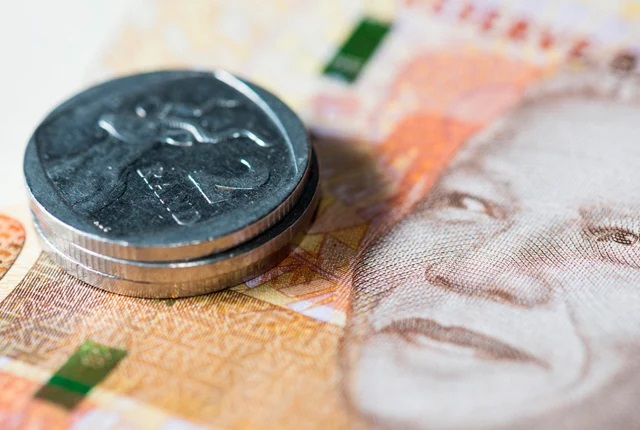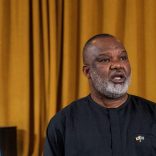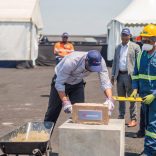M23 rebels reject accusations of gold theft from eastern Congo mine
Rand breaks below R15.00 vs dollar on better than expected GDP growth

in file CoM
South Africa’s better than expected Q3 GDP growth numbers and a falling US dollar saw the rand setting up a stronger trading range of R15.01 to R15.15 against the US dollar, says Bianca Botes, executive director at Peregrine Treasury Solutions.
The local unit broke through R15.00, and is eyeing a sustained run below that barrier. It comes after the South African economy saw a rebound in Gross Domestic Product (GDP) during the third quarter of 2020. GDP increased by 66.1% quarter-on-quarter annualised (seasonally adjusted).
“The 13.5% growth for the quarter was the first positive return after four negative quarters,” said Luigi Marinus, portfolio Manager at PPS Investments.
“It was largely expected that GDP would rebound as lockdown restrictions, that greatly affected the second quarter GDP growth, were lessened and economic activity could increase during the third quarter. Year-on-year GDP growth still saw a contraction of 6.0% highlighting that even after the strong rebound a full recovery has not yet been achieved.”
All 11 industries delivered positive growth in the third quarter after 10 of the 11 contracted in the second quarter.
Investec chief economist Annabel Bishop said in a note on Monday that the rand has averaged R15.93 versus the dollar so far this quarter and since mid-November, it has averaged R15.31.
This was despite credit rating downgrades by rating agencies Fitch and Moody’s.
“Today sees South African retail sales data, CPI and business confidence numbers, while US JOLTS job openings will be released later this afternoon,” Botes said. JOLTS Job Openings is a survey done by the US Bureau of Labor Statistics to help measure job vacancies.
The rand traded at its worst ever level to the dollar – R19.26 – in early April as South Africa struggled with the coronavirus lockdown and ratings downgrades.
The local currency has since gained against a weakening dollar as confidence returned to markets and money started to flow into emerging economies.
Nedbank said the country’s trade surplus and portfolio inflows are partly behind the rand’s strength. There is also a hunt for higher yields with ultra-low interest rates in advanced economies like the United States and Europe.
With the South African bond market currently offering some the highest real yields in the world, it is an attractive investment option, the financial services firm said.
Positive news about Covid-19 vaccines has also helped to ease economic concerns and prompt a move back into emerging markets, including South Africa.
The rand traded at the following levels against the major currencies at 07h00 on Wednesday (9 December):
- Dollar/Rand: R14.92 (-1.52%)
- Pound/Rand: R19.95 (-1.36%)
- Euro/Rand: R18.09 (-1.41%)
GDP data
In a research note on South Africa’s GDP data, Nedbank said that the country’s economic recovery is expected to continue – albeit at a much slower pace.
Production in most sectors will probably continue to normalise in the final quarter, supported by stronger global demand and firmer commodity prices. However, underlying structural constraints will still weigh on output, it said.
“On the consumption side, consumer spending is expected to be supported by low-interest rates and subdued inflation. However, the increase will be limited by a weak job market, which depress consumer incomes and confidence.
“The outlook for private sector investment spending remains bleak due to limited progress with structural reforms and fiscal consolidation, with private sector likely to be crowded out of the capital markets.”
Nedbank said that general government spending will be limited by the urgent need to for fiscal consolidation.
“We expect real GDP growth to normalise at around 3% q-o-q in the fourth quarter, which will reduce the annual rate of contraction for calendar 2020 to – 7.2% from our earlier estimate of -8%.”
Bishop said structural problems remain to trip up sentiment, particularly the build-up of sovereign debt in most countries over the past year.
She said that risk-on sentiment cannot be taken for granted in global financial markets.
“With the Northern Hemisphere autumn, winter and spring typically a risk-on period anyway, the positive sentiment that has supported the rand cannot be relied on to continue throughout 2021,” Bishop said.
“Going forward the growing concern is the possibility of a second wave of infections and the policy that will be required should this manifest. With the prospect of a number of vaccines being approved across the world it may be a matter of time before we see industries return to their full capacity and a normalisation of growth levels in South Africa,” said Marinus.












Leave a Reply
Be the First to Comment!
You must be logged in to post a comment.
You must be logged in to post a comment.